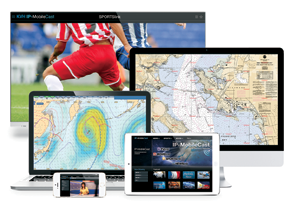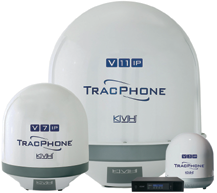The maritime industry is experiencing an exploding demand for broadband connectivity. Data and connectivity enable ship owners to accomplish many goals, from reduced fuel consumption through voyage planning to increased safety through updated training programs delivered to crew while they are onboard. Indeed, many of the maritime industry’s most pressing challenges can be addressed with connectivity.

The challenges to be faced include: attracting and retaining quality crew, many of whom are digitally competent and expect access to social media while onboard vessels; meeting increasingly complex regulatory expectations; and running smarter vessels through the use of remote maintenance, advanced weather and route planning, and electronic charts.
Crew Welfare
To improve crew welfare, maritime operators need to provide connections to home. In today’s digital world, broadband connectivity is central to social life. Younger seafarers, in particular, are personally dependent on modern communications services, such as social media and email. However, providing Internet access to meet crew members’ increasing demand for broadband becomes problematic if bandwidth is not prioritized for operational use, not to mention the budgetary factors that must be considered. In addition, onboard access to movie and TV entertainment and updated news from home has typically been limited in the variety of offerings.
The need to address crew welfare is being driven by maritime operators who want to attract and retain top crew as well as by a new MLC-2006 regulation that requires decent working conditions for seafarers around the world. MLC-2006 recommends that seafarers are given “reasonable access” to ship-to-shore telephone communications, email, and Internet services on the vessel.
Operational Efficiency
To improve operational efficiency, maritime operators need to ensure their vessels have connections to their shore-based offices, as well as the ability to use data-driven applications on the vessel. For example, engine monitoring, remote maintenance, and other applications that involve Machine-to-Machine (M2M) technology and the Internet of Things (IoT), can enhance maritime operations and support the sophisticated systems found onboard modern vessels. However, all rely on broadband connectivity.

Advanced weather and route planning relies on real-time data that include high-resolution weather charts as well as wave and tide information that has typically been too expensive for a ship to receive by satellite connection in a timely manner. At the same time, new regulations that mandate a reduction in fuel emissions are driving the need for ships to engage in more sophisticated voyage planning.
There are also new regulations requiring ships to use electronic charts on the bridge for navigation and safety. For a ship to receive updated chart databases has typically been impractical via broadband, due to the large size of the database files.
Multicasting Technology
As the maritime industry seeks a new approach for receiving the sizable amount of entertainment and operational content needed on vessels, KVH has developed an innovative solution that uses multicasting technology. With multicasting, one transmission sends files to all vessels at once. The content is cached on an onboard server for immediate access by subscribing vessels. This approach stands in stark contrast to other satellite providers’ current practice of sending files individually to each user on a receiving vessel and then charging per megabyte for the transmission. By using multicasting technology, the large multimedia, weather, and chart files can be delivered ‘over the top’ of the satellite network, never affecting the quality of the Internet service onboard the vessel.
Last year, KVH launched its IP-MobileCast™ content delivery service using multicasting technology. Multicasting allows cost-effective delivery of gigabytes of operations data to ships at very low cost. The efficiency is driven by the complete integration of network, content providers, and content delivery. Affordable connectivity opens a new generation of operational services for vessels including charting, voyage optimization, weather, and training.
Training is especially valuable when the programs can be sent via the IP-MobileCast service for the convenience of crew members, who are then able to attain higher levels of certification while onboard the vessel rather than needing to attend land-based training sessions. IP-MobileCast’s TRAININGlink™ channel can multicast entire training courses and time-sensitive updates to ships at sea. Training schedules and crew test scores can also be synchronized and tracked easily.
KVH’s Satellite Network
With the commercial maritime industry increasingly reliant on broadband services to enhance crew welfare and improve operational efficiency, KVH Industries is addressing these needs by expanding the capacity of its global VSAT network and supporting the new multicasting services.
KVH recently enhanced its mini-VSAT Broadband(sm) satellite network with additional capacity for the Asia-Pacific region, the Pacific Northwest, and the eastern coast of Canada and the U.S. to support heightened demand from customers engaged in a wide range of commercial maritime activities around the world, including offshore oil and gas, fishing, and shipping.
The mini-VSAT Broadband network utilizes 17 satellites and 24 transponders to provide global coverage, and is the most extensive C/Ku-band maritime VSAT network in the world. In addition, KVH designed the network for rapid expansion; KVH can access abundant commercial satellite capacity by working with leading commercial satellite providers.
KVH and its technology partner, ViaSat, Inc., use ArcLight® spread spectrum technology to deliver fast broadband service, with Internet download speeds up to 4 Mbps. With its enterprise-grade infrastructure, the mini-VSAT Broadband network carried 500 TB of data and 25 million voice minutes in 2014. Designed exclusively for the mini-VSAT Broadband network, KVH’s unique TracPhone® V-IP satellite communications antenna systems are built 85 percent smaller than typical VSAT antennas to install more easily on all vessels. Antenna sizes range from the 37 cm (14.5 inch) diameter TracPhone V3-IP, to the 60 cm (24 inch) diameter TracPhone V7-IP, and the 1.1 meter (42.5 inch) diameter TracPhone V11-IP.
Keeping Data Secure
KVH is also enhancing the mini-VSAT Broadband network by ensuring data that travels over the network is extremely secure. To accomplish this necessity, KVH recently implemented a global private MPLS network connecting all of the teleports and satellite beams in the
mini-VSAT Broadband network. The MPLS network aggregates all satellite traffic and provides Internet egress at “MegaPOPs” (point-of-presence access points) located in North America, Europe, and Asia. State-of-the-art firewalls and redundant high-speed Internet connections ensure security and reliability of all customer traffic. In addition, a Global Static IP service allows one public IP to be used to securely access a vessel from the Internet, regardless of vessel location.
Cost Savings Through Connectivity
Maritime operators will continue to face many challenges to stay competitive, and broadband connectivity is increasingly being seen as a way to enhance operations and to also save money. Satellite communications costs have typically accounted for a mere 0.3 percent of a vessel’s operating cost. However, having an efficient, effective, and managed network can help save 10 percent or more on vessel expenses. These savings are realized through operational efficiency, performance optimization, regulatory compliance, and reduced crew recruitment and retention costs.
KVH is unique in the maritime industry for providing every aspect of a ship’s satellite communications needs—onboard hardware, global connectivity, entertainment and operations content, and multicasting content delivery. With KVH, maritime operators can use broadband connectivity to better meet their crew welfare and operational efficiency needs, and can also address the consubstantial need for affordable delivery of entertainment and operational content onboard vessels by utilizing the IP-MobileCast content delivery service. For more information, visit www.ipmobilecast.com.
Rick Driscoll, VP of Satellite Products and Services, joined KVH in 2001 and was instrumental in the development of the mini-VSAT Broadband global satellite communications network. Mr. Driscoll holds bachelor’s degrees in Physics and Electrical Engineering and a master’s degree in Electrical Engineering.

KVH Oil Field VSAT
On land, the era of the digital oil field has arrived, and is transforming oil and gas operations on many fronts—from exploration to production.
The benefits of broadband connectivity at remote oil field sites include predictive maintenance, real-time invoicing and billing, data security, and an end to guesswork about whether cellular service is going to work.
The value of always-on connectivity comes down to the fact that oil and gas company headquarters can make decisions based on real-time data and information from the remote sites.
With new methods for oil extraction, it’s essential that key people are able to analyze and monitor data quickly. KVH’s solution for oil field VSAT includes compact and rugged TracPhone V-IP satellite antenna systems designed exclusively for the mini-VSAT Broadband network.
For more information about oil field VSAT technology from KVH, visit the website, www.kvh.com/oilandgas.



